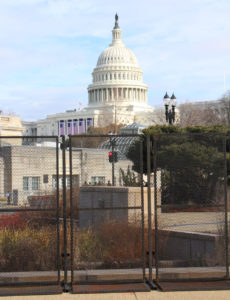By Louise Parker Kelley

It’s Martin Luther King Jr. Day and I can’t go see his memorial. I must keep out of the Capitol, I cannot see Rosa Parks’ statue. I can’t go anywhere on the National Mall. There are soldiers protecting it, and tall fencing, and orders from Mayor Bowser and the DC Police, and the Park Police, the Capitol Police, the National Guard, and they all say, Keep Out. I know why, everyone knows why. There was an armed home invasion of the People’s House, and it failed, but now it must be defended –– perhaps well beyond Inauguration Day on the 20th. The barriers may have to stay, just as the concrete barriers and bollards have remained around government buildings for the past twenty years.
Large numbers of police and soldiers showed up hours after the mob stormed the Capitol, and now there are 20,000 troops stationed in and around the Mall. It isn’t the first time the city had the army show up. And we don’t seem to have learned from the past. Even the recent past. Troops were posted at the Mall in June, after some graffiti was sprayed near the Lincoln Memorial and across part of the National Mall World War II Memorial after Black Lives Matter protests. Concern about the “optics” of that event made authorities hesitate to send any troops to protect the Capitol on January 6th.
This is what is happening in the town where I was born and raised, where so many respectful civil demonstrations have given voice to divergent points of view. Yet there were other protests, other times when the armed forces in camo showed up to protect the Mall. One of them began the change in access to the Capitol itself: On March 1, 1971, a bomb exploded in the Capitol building. Thousands of dollars of damage was done, but no one was hurt. The Weather Underground said they did the bombing to protest the invasion of Laos by US troops as the Vietnam war expanded. The Weathermen were a radical faction of those opposed to the war; they frequently used arson and bombs as tools.
In May of that year, the Mayday demonstrations by anti-war protestors ended with over twelve thousand people arrested in D.C., many of them swept up by the DC police just for being around people who “looked like they were demonstrators.” The mass arrests were a demand from President Nixon, and the DC Police Chief, Jerry Wilson, agreed. The appalling conditions those detained suffered, as well as the use of military troops to round up the peaceful protestors, changed how large demonstrations were handled in DC. The local police tried to avoid making mass arrests; they received training on how to refrain from being brutal to those who called them names or mocked them. Lawrence Roberts, in his excellent book Mayday 1971, explains that “One judge erased the 1882 law that . . . prevented demonstrations on Capitol grounds . . . it was found unconstitutional on its face.” However, his book also notes that X-ray machines were then installed at most of the Capitol entrances and guards began searching briefcases, purses, and bags.
Security was increased again after 9/11 and then extended to the Congressional mail after the anthrax attacks in September of 2001. Now, after January 6th there will be yet another level. This is what we do. We react, and then federal land in the District becomes more remote, a reinforced fortress of fear. I myself want Congress protected, and I also want to be able to again stroll through the halls of Congress. There has to be new way, so we don’t keep repeating the past. Lest we say, while looking at razor wire, the chant I’ve heard at so many demonstrations: “This is what democracy looks like.”
• Louise Parker Kelley is editor of “Called to the Mall,” a collection of schoolchildrens’ essays about the Mall.
Tags: Mall security, National Mall
